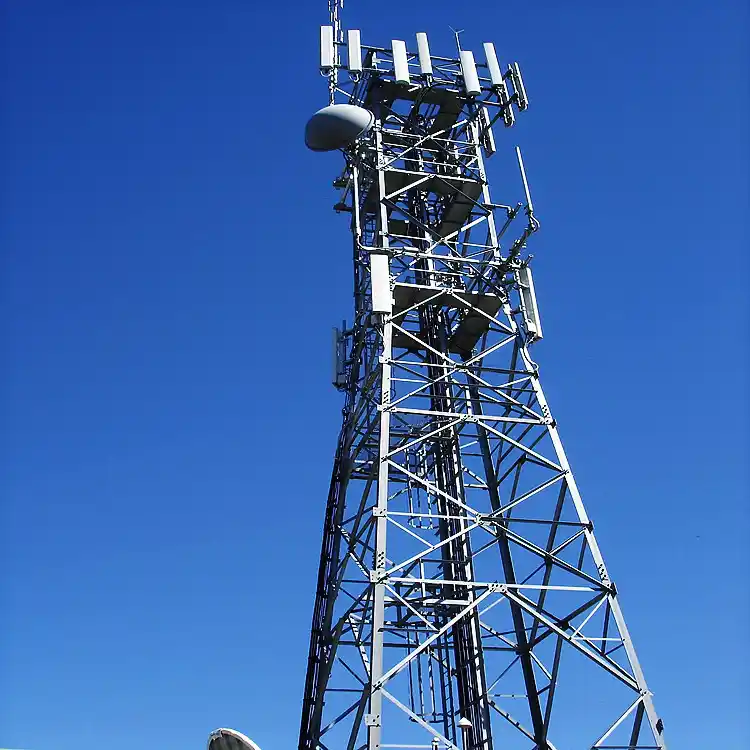Angle steel tower: Definition, Characteristics, Advantages and disadvantages, and applications
2025-08-05
An angle steel tower is a self-supporting tall steel structure constructed from angle steel profiles, commonly utilized in the fields of telecommunications, broadcasting, and meteorological monitoring. The cross-sectional shape of the tower body can vary, including square and triangular configurations, which provide excellent structural stability and load-bearing capacity. The design and manufacturing processes of angle steel towers are well-established, making them suitable for a wide range of high-rise structural applications.

Key Feature
The structural framework of angle steel towers is primarily composed of angle steel profiles, with connections typically achieved through bolted joints, resulting in minimal welding requirements. This modular design facilitates ease of construction and maintenance. Given the high strength and rigidity of angle steel, these towers are capable of withstanding substantial wind loads and other external forces, thereby ensuring structural integrity under diverse climatic conditions.
Design Wind Load
The standard design wind pressure for angle steel towers is generally set at 0.65 kN/m². This specification ensures structural safety and reliability during extreme wind events. Through appropriate design and material selection, these towers can effectively resist wind-induced stresses, thereby prolonging their service life.
Applicable Heights
Typically, angle steel towers are designed for installation heights of 40 meters, 50 meters, and 60 meters. This height range enables their application in various scenarios, including urban communication base stations and rural broadcasting towers. Depending on specific functional requirements, the tower height can be customized to suit different environmental and operational conditions.
Advantages
- **High Overall Rigidity**: The structural configuration of angle steel towers provides superior overall rigidity, enabling effective resistance to external forces.
- **Strong Load-Bearing Capacity**: Constructed using high-strength angle steel materials, these towers exhibit robust load-bearing capabilities, making them suitable for supporting a wide range of equipment.
- **Mature Design and Construction Technology**: The engineering and construction methodologies for angle steel towers are well-developed, ensuring consistent quality and safety standards.
- **Ease of Quality Control**: The fabrication process of angle steel components is relatively straightforward, allowing for precise control over manufacturing quality.
- **Convenient Transportation and Assembly**: The relatively lightweight components facilitate easier transportation and faster on-site assembly, thereby reducing overall construction time.
Disadvantages
- **High Steel Consumption**: The structural design necessitates a significant amount of steel, which increases the overall project cost.
- **Large Foundation Footprint**: Structural requirements result in a relatively large tower base, which may limit site utilization.
- **Complex Component Assembly**: The large number of individual components and connection nodes increases the complexity of both construction and maintenance.
- **Limited Reusability**: Due to their structural characteristics, angle steel towers are difficult to dismantle and relocate for reuse.
- **Component Size Limitations**: There are practical limitations on the maximum size of angle steel used in construction, typically capped at L200×24.
Application Scenarios
Angle steel towers are particularly suited for deployment in suburban, rural, and mountainous regions where land availability is abundant and aesthetic considerations are minimal. They are especially effective in applications requiring high structural rigidity and low deflection, such as microwave transmission towers and mobile communication base stations, where they provide stable support and optimal signal transmission performance.
In summary, angle steel towers represent a reliable and efficient solution for tall structural applications across a range of industries. Despite certain limitations, their numerous advantages and broad applicability continue to make them a vital component of modern infrastructure. Selecting the appropriate angle steel tower design can significantly contribute to the success and longevity of engineering projects.

Hey, I’m Chunjian Shu
"X.Y. Tower: Reliable, innovative solutions for high-quality towers and electrical equipment with professional service.
